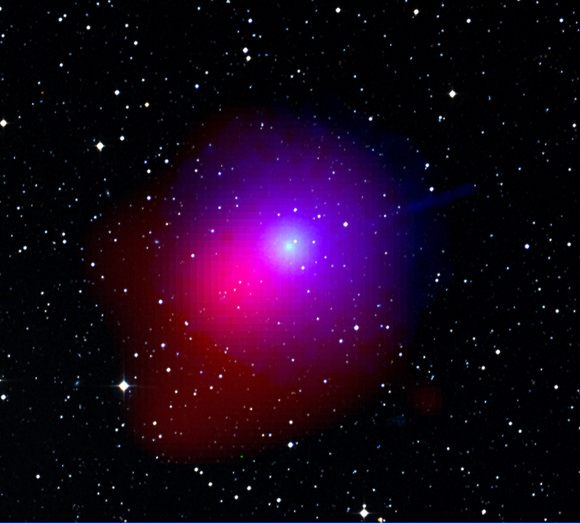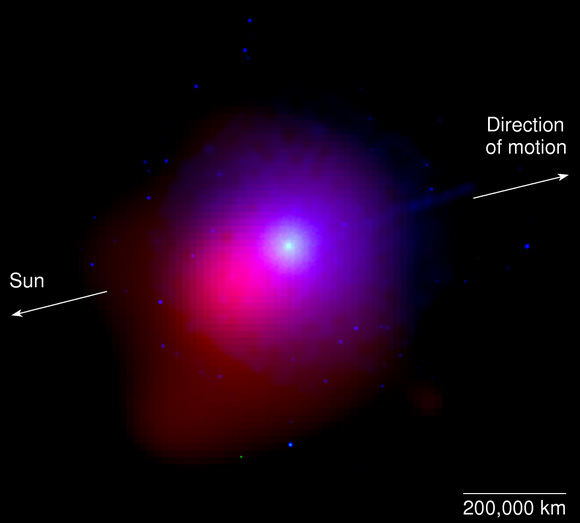[/caption]
The Swift spacecraft is doing double duty these days. Normally, the Gamma-ray Explorer satellite is on the lookout for high-energy outbursts and cosmic explosions. But now Swift is also monitoring Comet Lulin as it comes closer to Earth. For the first time, astronomers are seeing simultaneous ultraviolet and X-ray images of a comet. “The comet is releasing a great amount of gas, which makes it an ideal target for X-ray observations,” said Andrew Read, also at Leicester. And the ultraviolet data shows that Lulin is also shedding a huge amount of water, about 800 gallons of water each second!
“We won’t be able to send a space probe to Comet Lulin, but Swift is giving us some of the information we would get from just such a mission,” said Jenny Carter, at the University of Leicester, U.K., who is leading the study.
Comets are called “dirty snowballs,” as they are clumps of frozen gases mixed with dust. As comets venture near the sun, gas and dust are released. Comet Lulin, which is formally known as C/2007 N3, was discovered last year by astronomers at Taiwan’s Lulin Observatory. The comet is now faintly visible from a dark site. Lulin will pass closest to Earth — 38 million miles, or about 160 times farther than the moon — late on the evening of Feb. 23 for North America.
On Jan. 28, Swift trained its Ultraviolet/Optical Telescope (UVOT) and X-Ray Telescope (XRT) on Comet Lulin. “The comet is quite active,” said team member Dennis Bodewits, a NASA Postdoctoral Fellow at the Goddard Space Flight Center in Greenbelt, Md. “The UVOT data show that Lulin was shedding nearly 800 gallons of water each second.” That’s enough to fill an Olympic-size swimming pool in less than 15 minutes.

Swift can’t see water directly. But ultraviolet light from the sun quickly breaks apart water molecules into hydrogen atoms and hydroxyl (OH) molecules. Swift’s UVOT detects the hydroxyl molecules, and its images of Lulin reveal a hydroxyl cloud spanning nearly 250,000 miles, or slightly greater than the distance between Earth and the moon.
The UVOT includes a prism-like device called a grism, which separates incoming light by wavelength. The grism’s range includes wavelengths in which the hydroxyl molecule is most active. “This gives us a unique view into the types and quantities of gas a comet produces, which gives us clues about the origin of comets and the solar system,” Bodewits explains. Swift is currently the only space observatory covering this wavelength range.
In the Swift images, the comet’s tail extends off to the right. Solar radiation pushes icy grains away from the comet. As the grains gradually evaporate, they create a thin hydroxyl tail.
Farther from the comet, even the hydroxyl molecule succumbs to solar ultraviolet radiation. It breaks into its constituent oxygen and hydrogen atoms. “The solar wind — a fast-moving stream of particles from the sun — interacts with the comet’s broader cloud of atoms. This causes the solar wind to light up with X rays, and that’s what Swift’s XRT sees,” said Stefan Immler, also at Goddard.
This interaction, called charge exchange, results in X-rays from most comets when they pass within about three times Earth’s distance from the sun. Because Lulin is so active, its atomic cloud is especially dense. As a result, the X-ray-emitting region extends far sunward of the comet.
“We are looking forward to future observations of Comet Lulin, when we hope to get better X-ray data to help us determine its makeup,” noted Carter. “They will allow us to build up a more complete 3-D picture of the comet during its flight through the solar system.”
Source: NASA


All comets amaze me. In 1996, I had an older co-worker, he never saw a comet, and did not think they will be nothing but a starry object. We worked lated one evening to finish a project and I knew comet Hyakutake was
up, I said you want to see a comet that’s about 1 mile diameter about 16million miles,
we went to the roof, and there is light pollution in the Sacramento California Capital Mall area, I then pointed, it was dark orange and about 2.5x the size of the moon in the sky- he said, how could anything so far and so small do that- I said that’s what comets are about, amazing. We independly went to dark sites and saw the ‘tail’ which amazed all.!! About a year later, everyone in our offices and building saw Hale-Bopp, regardless of the light pollution, the length of time Hale-Bopp was visible , I got flooded with E-Mail about the comet as many thought I was an expert on comets- I told them that is wrong, I am not an expert, but to anyone who didn’t have an idea what is a comet, I was still flooded with E-Mail. Sometimes I think it was better not to say a thing lol
yes, sometimes it’s better to shut up
it says here 800 gallons a second and 800 gallons a minute in the article, any educated guesses on which one it is?
jason g:
it should be “per second” – an Olympic pool must hold a minimum of 660000 US gallons, which would take 13.75 minutes at 800Gallons a minute to fill.
Anyhow, I can’t see where it says “per minute”… maybe I need more coffee this morning?
😉
correction:
for “which would take 13.75 minutes at 800Gallons a minute to fill” read
“which would take 13.75 minutes at 800 Gallons a SECOND to fill”….
I REALLY need more coffee, it seems!
As always I have to translate the units.
If the U.S. liquid gallon is used, then 800 gallons is equal to a little bit more than 3000 litres, but because of this:
“… said Jenny Carter, at the University of Leicester, U.K., who is leading the study”
may be, it’s the UK imperial gallon, which leads to a little bit more than 3600 litres.
The “hydroxyl cloud spanning nearly 250,000 miles” translates to about 400,000 km.
By the way, there is a “200,000 km” in the first picture above – this is irritating 😉
“Lulin will pass closest to Earth … 38 million miles” is converted to about 60 million km.
On a similar occasion, I got the pertinent answer from some other reader, that Nancy Atkinson always does a good job, and that I could look up things as well in the original publication of the research team. That’s a good justification for the existence of Universe Today, of course 😉
All these trouble about units are completely unnecessary…I really dont know why we have a SI units at all….Is it for use only in school problems????
SI is the system most of the rest of the world uses. It’s really only America that insists on clinging to the Imperial system of measurements, which is archaic and less than adequate for scientific work.
X -rays from a comet.
It would seem to be some kind of electromagnetic phenomenon.
Nexus=I remember in the early 70s’ I have a cousin who moved to Canada from Germany,
Canada went ‘cold turkey’ converting to metrics, at the same time they tried to do a ‘gradual learning curve’ in the US by having the speed limit in both MPH and KPH- well, the KPH boards had shotgun holes on many of them and Americans refused and kept to it until trying to convert us with worthless. I have to agree the metric system is actually the proper system, but we are just too stubborn
to change!!! Perhaps this is why the US is
not too much into Science, our public school systems are bad, that’s why many of us sent our kids to private schools to learn better and
keep up with world technology. The US is now
falling not behind but no longer the leader
in technology.
Anaconda:
Please get busy doing something important and proveable, and return AFTER you have done that, please…
To clarify: It’s OK for me, if U.S. americans use miles, gallons, whatever they like, if they deal with each other only. But in publications dedicated to an U.S. american _and_ an international audience, they should use the metric system _too_, i.e. their “own” units – if they wish – _and_ the SI units.
By the way, it’s a sad fact, that the University of Leicester uses miles and gallons – which gallons? 😉 – too in the publications about Comet Lulin. Is it because they are forced by NASA? Do they use metric units internally?
It’s a madhouse. Wellcome to the carnival of units! Without pretty brasilian dancers.